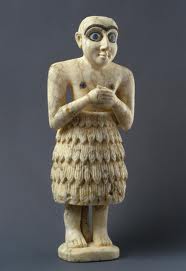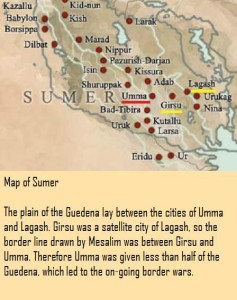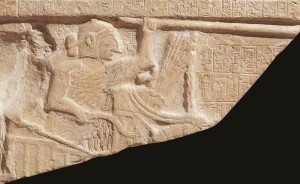“Eannatum The Conqueror” was written by Cam Rea
It’s around 2430 BCE in ancient Mesopotamia and Eannatum, King of Lagash, is in the midsts of establishing the first empire in history through constant warring.

One would think that Eannatum’s early military campaign would have begun by attacking the city-state of Umma, due to their previous disputes over the border and waterways. However, instead of going straight for Umma, Eannatum turned his attentions to the Elamites. There he “conquered Elam” and ripped up their “burial mounds.”
But why did Eannatum’s tour start with Elam? Well, the Elamites were a troublesome hill people, and in many ways they were still partly nomadic at the time. In other words, they had moved past being hunter-gatherers and had established a civilization like those living in Mesopotamia. However, they still clung to nomadic methods of warfare such as raiding.
An example is the destruction of Ur, which came much later. The actions of this event are found in The Lament of Ur, which states, “Enlil brought down the Elamites, the enemy, from the highlands … Fire approached Ninmarki in the shrine of Gu-aba. Large boats were carrying off its silver and lapis lazuli.”
This type of pillage-and-run tactic likely became monotonous to those living nearest to them. Additionally, Eannatum saw an economic opportunity in subjugating Elam.
He was confident that his military forces could protect Lagash while the main body was sent to conquer and confiscate the lands of Elam, which was rich in timber, precious metals, and stone. Eannatum’s take-over of Elam gave him the resources needed to provide for an army on the march.
Of Elam’s natural goods, one sticks out as a major attraction to Eannatum… tin, which could be found in mines that dotted the Zagros Mountains. Tin was more rare than copper and an essential ingrediant. Without tin to accompany the copper, the manufacturing of bronze weapons was impossible.
Not only did Elam produce its own tin, although how much they produced is uncertain, they also had valuable trade routes that ran through the region from the east. In fact, the mining and transportation of tin went beyond the Iranian plateau. These were all attractive features for the King of Lagash.
Next for Eannatum was the city-state of Urua, located in the northwestern Iranian province of Khuzistan and within the vicinity of Elam. The importance of conquering this city-state was due to its strategic postioning. Urua was on the Susiana plain, which controlled the passage that lead into what would be later become the southern portion of Babylonia.
Finally Eannatum went after his long-term enemy, Umma. As mentioned previously, Umma held an advantage over Lagash due to the bordering Shatt al-Gharraf waterway. By conquering Umma, Lagash had sole control over the waterway that filtered in from the Tigris and Euphrates Rivers. Furthermore, Lagash at last possessed the fertile fields of Guedena.
Eannatum’s tour of Elam, Urua, and Umma paid off. Eannatum now had provinces and regions rich with resources, including metal to produce weapons and fertile fields to grow food, both of which were used to feed and arm his forces.
But Eannatum was far from finished.
With an increase in resource-rich lands came an increase in manpower to replenish and increase the size of his ranks. Eannatum was drunk with power and looked west to quench his thirst.
With his eastern flank secured, the west was ripe for the taking. Eannatum led his forces to the city-state of Uruk, which was important for a number of reasons. The first was that Uruk sat along the Euphrates River and was not far from the Persian Gulf, making it a valuable trading city by both land and sea. Second, Uruk’s population was rather large and prosperous, fed by the surrounding fertile fields. This meant Uruk was desirable in terms of supplying the army with food and swelling the ranks with additional troops.
With Uruk conquered, Ur came next and its armies were put to the sword. Ur was also a valuable trading center, and like Uruk, offered a strategic location near the mouth of the Euphrates River that led into the Persian Gulf, which was used for importing and exporting resources.
At this point, Eannatum’s empire was flanked by three natural barriers: the Zagros Mountains to the east, the dessert to the west, and the Persian Gulf to the south. Eannatum’s only true threat now came from the north.
And so, Eannatum made his way north, eyeing the prize worthy religious target known as Kish. However, this time, things weren’t so simple. Zuzu, the king of Akshak, had enough of Eannatum’s war making and went out to confront the man who wished to own the world.
Zuzu, along with his forces, faced Eannatum and his army and a battle commenced. Eventually, Zuzu was killed in combat and his city-state of Akshak taken and incorporated into Eannatum’s ever increasing empire. With Akshak conquered, Eannatum marched into Kish with ease.
Eannatum, confident in his power, decided to take the title “King of Kish.” This names means much more than being the overlord of Kish. It implies that whoever has it, is also King of all of Sumer.
You would think that Eannatum would have been happy with his conquests, since he was now considered the king of Sumer. However, war is the health of the state and that rang true for Eannatum. Soon after Eannatum had taken over and centralised all of Sumer under his sole authority, city-states outside the sphere started to look attractive.
And so Eannatum’s empire continued to grow.


